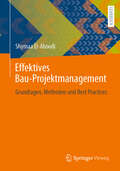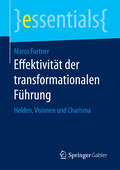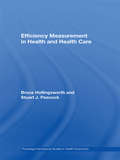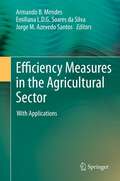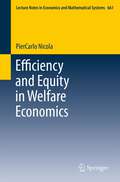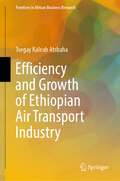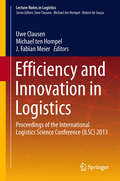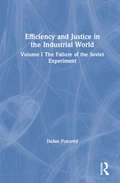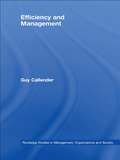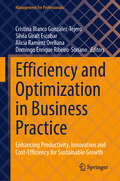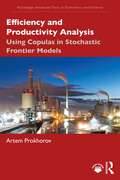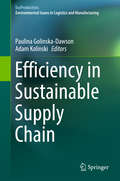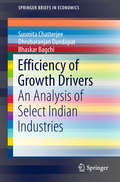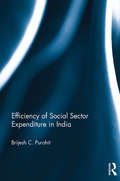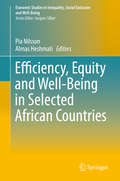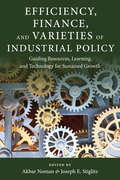- Table View
- List View
Effektives Bau-Projektmanagement: Grundlagen, Methoden und Best Practices
by Shymaa El-AboodiDieses Lehrbuch ist eine pragmatische Mischung aus fundiertem Wissen, langjähriger Erfahrung und umfassender praktischer Umsetzung der wesentlichen Methoden des Projektmanagements. Der systematische Aufbau enthält praktische Anwendungshilfen für die Projektarbeit. Das Lehrbuch gibt einen verständlichen Überblick über die Methoden, Werkzeuge und Best Practices, die für eine effiziente Realisierung von Bau-Projekten genutzt werden können. Das Buch möchte Einsteiger:innen in die Thematik dabei unterstützen, die Herausforderung der Projektarbeit zu meistern und ihre Fähigkeiten und Kenntnisse als Projekt-Manager:in weiterzuentwickeln.
Effektives Customer Relationship Management: Instrumente - Einführungskonzepte - Organisation
by Stefan Helmke Matthias Uebel Wilhelm DangelmaierDieses CRM-Standardwerk behandelt die wesentlichen Fragen im Rahmen der Einsetzung und Organisation von Customer Relationship Management. Dies betrifft sowohl die Verzahnung mit Marketing- und Vertriebsprozessen, die systematische Zielbildung als auch die Ressourcensteuerung. Renommierte Autoren liefern wertvolle praxisorientierte Fakten, um die zielgerichtete Planung, die Umsetzung und die nachhaltige organisatorische Verankerung zu gewährleisten und damit zur Steigerung der Effizienz und Effektivität des CRM-Ansatzes in der Unternehmenspraxis beizutragen.In der 7. Auflage wurden alle Beiträge überarbeitet und neue Entwicklungen integriert.
Effektivität der transformationalen Führung: Helden, Visionen und Charisma (essentials)
by Marco FurtnerIn diesem essential beschreibt Marco Furtner die Grundlagen zur visionären und charismatischen Einflussnahme in der Führung (Ist Charisma angeboren oder trainierbar?). Der Autor gibt einen verständlichen Überblick zur Effektivität der transformationalen Führung, welche die Führungsforschung revolutioniert hat: In den letzten 30 Jahren wurde kein anderer Führungsansatz so häufig untersucht und diskutiert. Der zentrale Grund liegt darin, dass die transformationale Führung eine idealisierte Form von Führung darstellt und den "Glanz" der charismatischen Einflussnahme nutzt. Umso überraschender ist es, dass bei einer deutschsprachigen Buchrecherche zum Titel "Transformationale Führung" bislang lediglich studentische Studienarbeiten aufscheinen.
Efficiency Costs of Myanmar's Multiple Exchange Rate Regime
by Masahiro Hori Yu Ching WongA report from the International Monetary Fund.
Efficiency Criteria for Nationalised Industries (Routledge Revivals)
by Alec NoveFirst published in 1973, Efficiency Criteria for Nationalised Industries asks by what criteria we should judge the efficiency of nationalised industries, what we mean by saying they should be run commercially and where the public interest should lie. In this work, Professor Nove believes we answer these questions incorrectly due to a lack of understanding of economic theory and a desire to relate real world economics to that of the text book. The author says many economists, in a world of indivisibilities, complementarities and systems, persist in thinking in terms of one-dimensional, fragmented marginalism. Professor Nove, who is known for his writings on the Soviet economy, raises many points relevant to the East as well as the West. His work contributes to the economics of socialism, while also making the case for greater realism in economic theory in general.
Efficiency Measurement in Health and Health Care (Routledge International Studies In Health Economics Ser.)
by Bruce Hollingsworth Stuart J. PeacockThis book provides a concise synthesis of leading edge research in the theory and practise of efficiency measurement in health and health care. Whilst much of the literature in this area is confusing and impregnable, Hollingsworth and Peacock show the logical links between the economic theory underlying efficiency, the methods used in analysis and
Efficiency Measures in the Agricultural Sector: With Applications
by Emiliana L. D. G. Soares da Silva Jorge M Azevedo Santos Armando MendesThe editors draw on a 3-year project that analyzed a Portuguese area in detail, comparing this study with papers from other regions. Applications include the estimation of technical efficiency in agricultural grazing systems (dairy, beef and mixed) and specifically for dairy farms. The conclusions indicate that it is now necessary to help small dairy farms in order to make them more efficient. These results can be compared with the technical efficiency of a sample of Spanish dairy processing firms presented by Magdalena Kapelko and co-authors.
Efficiency Ratios - Making the Most of Your Assets
by Karen Berman Joe KnightEfficiency ratios help you evaluate how efficiently you manage certain key balance sheet assets and liabilities. Financially intelligent entrepreneurs learn how efficiency ratios measure performance, and are then able to have a direct and immediate impact on their company's cash position. This chapter is excerpted from "Financial Intelligence for Entrepreneurs: What You Really Need to Know About the Numbers."
Efficiency Ratios: Making the Most of Your Assets
by John Case Karen Berman Joe KnightEfficiency ratios help you evaluate how efficiently you manage certain key balance sheet assets and liabilities. This chapter illustrates how efficiency ratios measure performance, enabling you to have a direct and immediate impact on your company's cash position.
Efficiency and Equity in Welfare Economics
by Piercarlo NicolaIncreasing efficiency in generating national income and improving equity in its distribution among economic agents is at the forefront of priorities of most modern economies. This book presents a model which aims to maximize a symmetrical welfare function under certain constraints which consider both efficiency and equity, i.e. taxes and subsidies, implemented by a public authority. The model is numerically implemented and considers a set of economic agents with starting incomes that satisfy Pareto income law under various values of the alpha parameter. Also, the model implementations respect the social production function. Various experiments are presented which show how income inequality (measured by means of the Lorenz curve and, what I call, the Lorenz-Gini inequality index) and measures of poverty are sensibly reduced by redistributing national income without lowering efficiency in production. A case study, or application, of Italian personal income in 2008 is also presented.
Efficiency and Growth of Ethiopian Air Transport Industry (Frontiers in African Business Research)
by Tsegay Kaleab AtsbahaThis book evaluates the efficiency and growth of the Ethiopian air transport sector through careful analysis. It provides essential research input for air transport industry practitioners in planning and resource management as well as for academics of advanced efficiency analysis who need to work and study in airports and the airline industry. The book analyzes the theoretical and practical implications of air transport growth determinants, airports' cost and production efficiency, including labor use efficiency by taking their respective determinant factors. The findings and policy implications of each research work provide important inputs for government policymakers and air transport planners to consider the causality of economic growth versus airlines growth and other determinants, to take lessons on the proper resource allocation in the application of airport cost and production efficiency, human capital, investment cost, price of capital, and labor inputs during the development and expansion of airports and airlines. This book is the first of its kind on the Ethiopian air transport industry and serves as a much-needed reference for the African air transport industry as well as other developing countries in terms of airport costs, production, labor use efficiency and airline growth perspectives.
Efficiency and Innovation in Logistics: Proceedings of the International Logistics Science Conference (ILSC) 2013
by Michael Ten Hompel Uwe Clausen Fabian MeierThe importance of logistics in all its variations is still increasing. New technologies emerge, new planning methods and algorithms are developed, only to face a market with a growing complexity and the need of weighting monetary costs against ecological impact. Mastering these challenges requires a scientific viewpoint on logistics, but always with applications in mind. This volume presents up-to-date logistics research in all its diversity and interconnectedness. It grew out of the "International Logistics Science Conference" (ILSC) held in Dortmund in September 2013, bringing together leading scientists and young academics from nine different countries. The conference was jointly organized by the "Efficiency Cluster Logistics" and the "Fraunhofer Institute for Material Flow and Logistics". The Program Committee used a double blind review process to choose the 12 strongest contributions, which were then grouped in four areas: - Sustainability logistics, including electric mobility, smart information, communication technologies and corporate social responsibility management - Intralogistics, including the detection of autonomous vehicles, 3D computer vision and sensor functions for forklift trucks - Transport logistics, including distribution centre organization, delivery performance in railway systems and logistics reference modelling - Logistics facilities, including environmental impact of container ports, parcel sorting systems and model based systems engineering.
Efficiency and Justice in the Industrial World: v. 1: The Failure of the Soviet Experiment
by Dusan PokornyIn the last years of the Soviet Union, with remarkable suddenness, it became commonplace to observe that what the country needed was a free market, private property and integration into the global economy. But why (aside from the obvious fact that the alternative was failing) should this consciousness dawn in our day? This book argues that the time has come to reflect on what the epochal events of our era are teaching us about larger questions - the relationship between economy and society, culture and market. Dusan Polorny asks precisely these questions, revisiting the ideas of classic and contemporary philosophers in the light of the failure of the Soviet order and the exigencies of post-Soviet transformation. As Pokorny also points out, integration in a post-industrial global economy entails profound changes in the domain of property rights, a redefinition of the relation between equity and efficiency, and a regrounding of national consciousness. The present volume examines the implications of these demands for the post-Soviet societies; another, on the European and North American experiments in economic integration, is in preparation.
Efficiency and Management (Routledge Studies in Management, Organizations and Society)
by Guy CallenderIt is widely accepted that management concepts such as strategic management, human resource management and management development have a well-defined body of knowledge designed to inform management praxis, however the notion of efficiency has no such body of knowledge to support its application within management praxis. This book proposes the replacement of the generalised term efficiency with the more comprehensive notion of performance efficiency to provide a reliable basis on which to evaluate management behaviour. Given the scope of the investigation, the outcome is not designed to prove the success or failure of the inherent nature of efficiency, but rather to establish a new starting point for yet wider empirical research. At a macro-level, it advances the proposition that the notion of efficiency has become an ideological statement of support for any management intention rather than a practical means to inform or evaluate a range of management actions.
Efficiency and Optimization in Business Practice: Enhancing Productivity, Innovation and Cost-Efficiency for Sustainable Growth (Management for Professionals)
by Cristina Blanco González-Tejero Silvia Giralt Escobar Alicia Ramírez Orellana Domingo Enrique Ribeiro-SorianoThis book aims to provide a comprehensive overview of the concept of efficiency in the business world, offering key tools and strategies for development and sustainability in a dynamic environment. Adaptation is essential in the digital age, where organizations are challenged to examine the costs associated with their production processes and adopt automation and innovation processes to enhance efficiency and remain competitive. Throughout the chapters, the keys will be identified for companies to recognize the need to balance economic growth with adaptation to the changing environment. The first part of the book presents a more theoretical vision of current variables that have the potential to impact organizational strategy, while the second part offers a more technical contribution focusing on specific processes and strategies. Thus, the dual nature of this book allows it to reach a specific readership, providing essential theoretical and practical knowledge for efficient organizational management. The potential audience for this book includes executives and managers from companies in various industry sectors, such as manufacturing, technology, financial services, accounting and consulting.
Efficiency and Performance of Bulgarian Private Pensions
by Gregorio ImpavidoA report from the International Monetary Fund.
Efficiency and Productivity Analysis: Using Copulas in Stochastic Frontier Models (ISSN)
by Artem ProkhorovThis book is an easy-to-understand guide to modeling productivity and efficiency using modern statistical tools. It introduces readers to the fundamentals of stochastic frontier analysis (SFA) and gradually takes them to the forefront of academic research in this area, examining the latest concepts and methods related to the use of copulas in SFA.Following a comprehensive review of classic methodology, Professor Artem Prokhorov covers topics in panel data modeling, in endogeneity in SFA, in joint modeling of technical and allocative inefficiency, and in optimal and robust prediction of inefficiency scores. This is done using copulas to capture various kinds of statistical dependence that have been previously ignored when modeling production. The classic and advanced topics are illustrated using practical examples and codes written in modern programming languages. As an important example, the book spells out the case where both the values of output and the ratio of inputs used in production are optimized simultaneously. Such simultaneity, if ignored, leads to biased estimates of productivity and returns-to-scale and may understate inefficiency.The book offers a useful reference for those interested in the newest robust methods of business analytics in the area of productivity and efficiency, with implications for strategy, budgeting, resourcing and benchmarking of firms, industries and production units more generally.
Efficiency in Business and Economics
by Tadeusz Dudycz Grażyna Osbert-Pociecha Bogumiła BryczThis book offers a collection of studies on various organizations' efficiency, criteria for evaluating efficiency, together with tools and methods for measuring efficiency. The articles included present an interdisciplinary look at efficiency, its essence and the principles of its measurement. They represent an attempt to seek the conceptual boundaries of efficiency, i. e. to clarify this abstract and multidimensional concept including its relation to innovation, competitiveness and intellectual capital. The contributions also identify a broad spectrum of conditions for achieving efficiency in various types of organizations and systems (e. g. health care, hybrid organizations, non-profit organizations), representing various industries (e. g. insurance, banking, tourism, agriculture).
Efficiency in Sustainable Supply Chain
by Paulina Golinska-Dawson Adam KolinskiThe book focuses on efficiency analysis in enterprises and describes a broader supply-chain context to support improved sustainability. The research and its outcomes presented here provide theoretical and empirical studies on efficiency analysis in the supply chain, including operational, economic, environmental and social aspects. This book sheds new light on the efficiency-assessment framework for practitioners and includes essential tips on how to improve the sustainability of supply-chains operations.
Efficiency of Growth Drivers: An Analysis of Select Indian Industries (SpringerBriefs in Economics)
by Bhaskar Bagchi Dhrubaranjan Dandapat Susmita ChatterjeeThis book covers three main areas, namely the pharmaceuticals industry, the telecommunications sector and the banking sector, with a focus on manufacturing and service. It includes a brief analysis of all three, particularly in the context of their evolution, current status, cost efficiency, and growth projections. The Indian pharmaceuticals market is the third-largest in the world in terms of volume and thirteenth-largest in terms of value; further, India is the world’s largest provider of generic drugs. India is currently the second-largest telecommunications market and has the third-highest number of internet users in the world. At the same time, the deregulation of foreign direct investment (FDI) norms has made banking one of the fastest-growing sectors and a top-five employment opportunity generator in the country. Further, the efficiency and profitability of India’s banking sector has assumed prime importance due to intense competition, customer demands and bank reforms. The book gauges the relative performance of the Indian banks based on certain key parameters. It then concisely presents the efficiency results, vividly portraying the industry’s current status and serving as a ready reference that will be valuable to students, academics and industry experts alike.
Efficiency of Social Sector Expenditure in India
by Brijesh C PurohitGovernment investments in social sector has always played an important role in tackling social issues and facilitated in the alleviation of poverty. Hence, budgetary expenditure to be mobilized for such investments needs to be efficiently allocated and utilized to maximize the greatest good. This book focuses on the social sector in India and provides an overview of the sector. The book looks at 15 major Indian states between the year 2000-2011 to see how these states had invested in social sector and whether they had met the criteria of efficient social sector investment. Using stochastic frontier models, the book provides an efficiency norm and making use of this normative estimate, it compares performance across 15 Indian states and suggests important policy implications to improve the future performance of the social sector. The book adopts various quantitative techniques in the analysis and establishes that inefficient and inappropriate allocation of inputs was made in both health and education sectors. The book suggests that such problems and future challenges could be overcome by an appropriate mix of emphasis in different activities. This book will provide insight for those who want to learn more about how to build the capacity of the social sector in more efficient manner by exploring the social sector of India.
Efficiency, Equality and the Ownership of Property (Collected Works of James Meade)
by James E. MeadeFirst published in 1964, this is a study of the extreme inequalities in the ownership of property, in economies across the globe. Professor Meade examines in depth the economic, demographic and social factors which lead to such inequalities. He considers a wide range of remedial policies – educational development, reformed death duties and capital taxes, demographic policies, trade union action, the socialization of property, the development of a property-owning democracy, the expansion of the welfare state. The argument is expressed in precise analytical terms, but the main exposition is free of mathematics and technical jargon and is designed for the interested layman as well as the economist.
Efficiency, Equity and Well-Being in Selected African Countries (Economic Studies in Inequality, Social Exclusion and Well-Being)
by Pia Nilsson Almas HeshmatiThis book addresses poverty and well-being, equity, and efficiency in selected African countries. The chapters focus on three main topics: studies in the measurement and analysis of well-being and vulnerability to poverty, women's empowerment, and the dynamics and determinants of income and efficiency among smallholders. The chapters in the first section examine poverty, well-being, and vulnerability to poverty, as well as social exclusion, with a focus on households in Ethiopia, Rwanda, and Tanzania. They highlight the need to consider multidimensional measures of well-being and vulnerability to poverty, the need to address the distribution of vulnerability across different segments of the population, as well as the importance of developing public policies aimed at poverty reduction and promoting the well-being of the poor. The next section deals with issues related to women’s empowerment, including a multidimensional case study of women’s empowerment in Ghana and women’s access to microfinance services in Ethiopia. The final section focuses on dynamics and determinants of income and efficiency among farm households in Ethiopia and Uganda. Using a variety of methodologies, this volume provides a multifaceted approach to studying poverty and well-being in a diverse range of locations. As such, it of use to undergraduate and graduate students studying African economics or economics of poverty and well-being, and will be appealing to public policymakers and international aid agencies.
Efficiency, Finance, and Varieties of Industrial Policy
by Joseph E. Stiglitz Akbar NomanIndustrial policy, once relegated to resource allocation, technological improvements, and the modernization of industries, should be treated as a serious component of sustainability and developmental economics. A rich set of complimentary institutions, shared behavioral norms, and public policies have sustained economic growth from Britain's industrial revolution onwards. This volume revisits the role of industrial policy in the success of these strategies and what it can offer developed and developing economies today.Featuring essays from experts invested in the expansion of industrial policies, topics discussed include the most effective use of industrial policies in learning economies, development finance, and promoting investment in regional and global contexts. Also included are in-depth case studies of Japan and India's experience with industrial policy in the banking and private sector. One essay revisits the theoretical and conceptual foundations of industrial policy from a structural economics perspective and another describes the models, packages, and transformation cycles that constitute a variety of approaches to implementation. The collection concludes with industrial strategies for facilitating quality growth, realizing more sustainable manufacturing development, and encouraging countries to industrialize around their natural resources.
Efficiency, Finance, and Varieties of Industrial Policy: Guiding Resources, Learning, and Technology for Sustained Growth (Initiative for Policy Dialogue at Columbia: Challenges in Development and Globalization)
by Stiglitz Joseph E. Noman AkbarIndustrial policy, once relegated to resource allocation, technological improvements, and the modernization of industries, should be treated as a serious component of sustainability and developmental economics. A rich set of complimentary institutions, shared behavioral norms, and public policies have sustained economic growth from Britain's industrial revolution onwards. This volume revisits the role of industrial policy in the success of these strategies and what it can offer developed and developing economies today. Featuring essays from experts invested in the expansion of industrial policies, topics discussed include the most effective use of industrial policies in learning economies, development finance, and promoting investment in regional and global contexts. Also included are in-depth case studies of Japan and India's experience with industrial policy in the banking and private sector. One essay revisits the theoretical and conceptual foundations of industrial policy from a structural economics perspective and another describes the models, packages, and transformation cycles that constitute a variety of approaches to implementation. The collection concludes with industrial strategies for facilitating quality growth, realizing more sustainable manufacturing development, and encouraging countries to industrialize around their natural resources.
